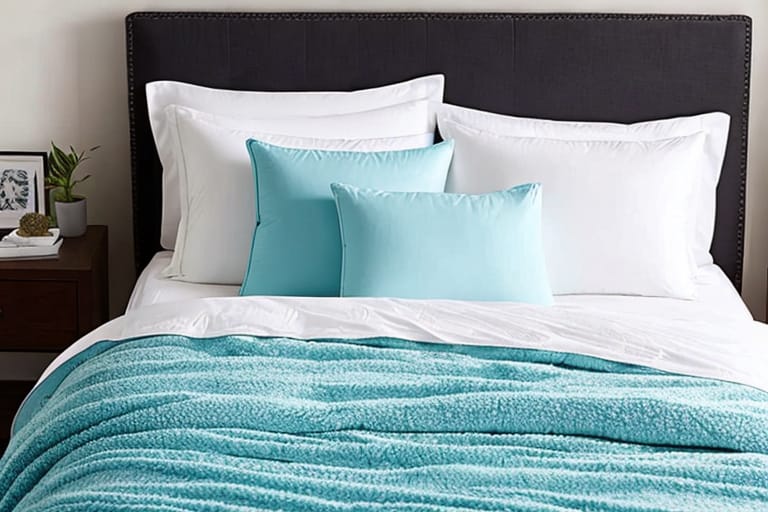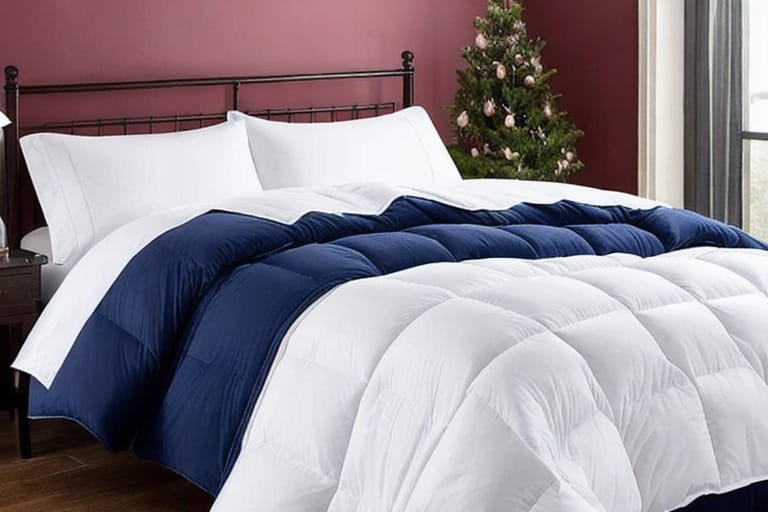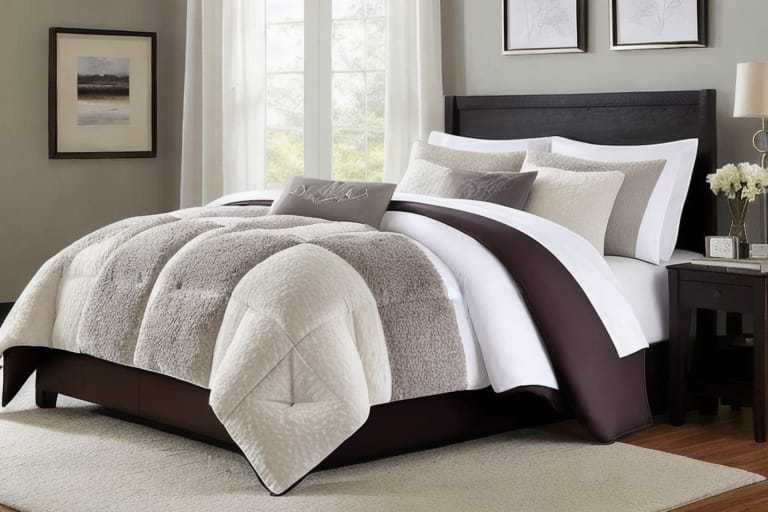Are you looking to purchase a down comforter but unsure what exactly they are stuffed with or how they differ from other comforters? This beginner’s guide will walk you through everything you need to know about down comforter fill, materials, construction, and key factors that impact comfort, longevity, cost, and more to help you select the best one suited for your needs.
An Introduction to Down as a Comforter Fill Material
Down refers to the layer of fine, fluffy feathers located underneath the exterior feathers of ducks and geese that help provide warmth and protection. This naturally insulating down material, when cleaned, sanitized and processed, is used as a fill or stuffing in bedding products like comforters, pillows, and mattress toppers to provide exceptional warmth and comfort.
Unlike cheap synthetic fills, natural down offers superior loft – the ability of down clusters to fully expand and create small air pockets that efficiently trap body heat. This results in lightweight yet incredibly warm, breathable and cushy comforters perfect for any season.
Fill power measures the loft or fluffiness of down – the higher the number, the better quality down with more insulation per ounce.
Comforters will typically contain 90% to 100% white down as fill, with the remainder white feathers. The finest quality down clusters come from mature geese and ducks as their clusters and filaments are larger.
Factors That Determine Down Comforter Quality
From the type and quality of down fill to the covering fabric, stitching and construction, several factors impact the overall comfort, durability and pricing of a down comforter.
Down Fill Power and Quality
The most critical factors determining comforter quality are:
- Fill power – This indicates the loft and fluffiness of the down fill.
- Fill power typically ranges from 300 to 900.
- Higher numbers over 600+ indicate superior fill that traps more body heat.
- Down cluster content – Quality comforters have a down content over 90% with the rest white feather fill. More down = more insulation and warmth.
- Down grade – This refers to down quality in terms of fill power, cleanliness, odor and color. The highest is AA Grade down.
- Fill weight – This specifies the total ounces of down fill inside the comforter and affects warmth. Comforters range from 15 oz to 35 oz.
Shell Fabric Material and Properties
The outer shell fabric or casing that holds the down fill plays a critical role in:
- Preventing quill shafts from uncomfortably poking through
- Improving down containment and loft
- Allowing moisture wicking
- Increasing durability
High quality materials like 100% cotton sateen or cotton/silk provide optimal breathability, durability and luxurious, lightweight comfort:
- Thread count – Fabric thread count from 200 to over 1000 impacts softness, strength and pricing.
- Weave – Specialized weaves like damask stripes increase down retention inside comforter compartments.
- Moisture resistance – Protects down integrity.
- Stain resistance – Ease of cleaning and maintenance.
Key Differences in Construction and Design
From stitching method to size options, how a down comforter is crafted makes all the difference.
| Construction Feature | Significance |
|---|---|
| Compartments | Specialized stitched compartments evenly distribute and help retain fill |
| Baffle boxes | Narrow sewn fabric walls create separate down filled boxes to prevent shifting |
| Gusset | Expands fill capacity for maximum lofting of down |
| Edge stitching | Reinforces outer edges, preventing tears |
| Corner loops | Allow easy securing of duvet cover |
| Tag clues | ID down fill quality, materials, origin etc |
Design elements like color schemes, patterns and details like piping give down comforters part of their visual appeal:
Caring For Your Down Comforter
Follow these best practices to retain loft, extend comforter lifespan, and uphold warranty protections:
- Dry clean every 2 years – Or wash gently at home up to twice a year as needed in commercial machines.
- Natural drying – Line dry or tumble dry on low.
- Regular fluffing& shaking – Every month, fluff gently to maintain even fill distribution.
- Cool storage – Off-season, store loosely folded in breathable bags in cool, dry spaces.
Steam cleaning services can refresh and revitalize down between washes while repair services address tears, broken stitching etc.

Choosing the Best Down Comforter Brands
Stick to top manufacturers known for ethical down sourcing and stellar quality like these longstanding names:
When comparing options, analyze independent testing on fill power, materials etc and read buyer reviews.
| Brand | Unique Selling Points |
|---|---|
| Snowe | • Mix of contemporary and traditional aesthetic • Exceptional warmth-to-weight ratio • Advanced humidity resistance technology |
| Brooklinen | • Ethical down sourcing • Strong emphasis on simplicity of design • lightweight yet cozy options perfect for all seasons |
| Parachute | • Relaxed, resort-style looks • Made of premium European down • Durable, soft sateen shell fabric |
| Riley Home | • Family-owned company since 1926 • Range of reversible two-toned styles • High fill power |
| East End Embroidery | • Handcrafted boutique-quality stitching and details • Premium European goose down |

Final Considerations in Down Comforter Selection
Keep these last tips in mind as you evaluate options to determine the perfect one your needs:
- Test material samples when possible at stores – Check softness, breathability etc
- Assess temperature regulating abilities – Warm for winter, cool enough for summer?
- Read return policies – Many brands allow trial periods for home testing comfort.
- Allergy sufferers should look for reliable hypoallergenic certification seals to indicate strict standards for cleanliness have been met.
- Compare warranty coverage – Typically up to 10 years against material or manufacturing defects.
- Analyze what value proposed features will bring – Make choices aligned with your budget and priorities for an optimal sleep experience.
With all these insights on fill materials, quality benchmarks, care and more, you are now equipped with the knowledge to shop smartly, save money, and select a down comforter that checks all the boxes for your bedroom.
Frequently Asked Questions
What is the average price of a down comforter?
The average price range is $200 to $500 depending on size, materials, construction quality and design. Entry-level budget options start around $150 while high-fill power luxury comforters from premium brands can cost over $600.
What thread count is best for a down comforter?
Look for a cotton shell fabric thread count between 400 and 600. This offers the best balance of softness, breathability and strength. Higher thread counts over 1000 can feel excessively heavy and trap more heat.
How frequently should you wash a down comforter?
Only wash a down comforter once or twice annually as needed in commercial machines, following any special care instructions. More frequent washing can damage down clusters and reduce filling efficiency over time. Proper storage and regular reshaping/fluffing can allow you to wash less often.
How do I know if a comforter contains ethical down?
Look for reputable brands that state a commitment to responsible down sourcing and safe, humane practices. Certifications like the Responsible Down Standard also indicate adherence to animal welfare standards through third party auditing.
What are the best hypoallergenic options?
For allergy sufferers, certified hypoallergenic comforters have undergone rigorous high heat treatment and washing to sanitize and remove dust, dander and allergens from the down fill. This certification provides assurance of cleanliness.
Frequently Asked Questions
What is the average price of a down comforter?
The average price range is $200 to $500 depending on size, materials, construction quality and design. Entry-level budget options start around $150 while high-fill power luxury comforters from premium brands can cost over $600.
What thread count is best for a down comforter?
Look for a cotton shell fabric thread count between 400 and 600. This offers the best balance of softness, breathability and strength. Higher thread counts over 1000 can feel excessively heavy and trap more heat.
How frequently should you wash a down comforter?
Only wash a down comforter once or twice annually as needed in commercial machines, following any special care instructions. More frequent washing can damage down clusters and reduce filling efficiency over time. Proper storage and regular reshaping/fluffing can allow you to wash less often.
How do I know if a comforter contains ethical down?
Look for reputable brands that state a commitment to responsible down sourcing and safe, humane practices. Certifications like the Responsible Down Standard also indicate adherence to animal welfare standards through third party auditing.
What are the best hypoallergenic options?
For allergy sufferers, certified hypoallergenic comforters have undergone rigorous high heat treatment and washing to sanitize and remove dust, dander and allergens from the down fill. This certification provides assurance of cleanliness.








